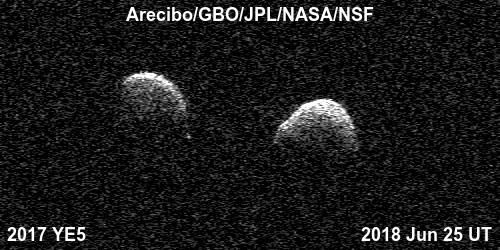Massive Near-Earth Asteroid Spotted Last Year Isn’t Hurtling Alone In Space

Recently, a series of observations from NASA and other ground-based observatories revealed a massive near-Earth asteroid detected last year isn’t hurtling alone through space.
First spotted by the Morocco Oukaimeden Sky Survey, asteroid 2017 YE5 is accompanied by a similar-sized partner — a space-rock that remains locked in a binary orbit, the space agency revealed. It keeps orbiting its partner all the time, making the asteroid pair very hard to discover.
After initial detection in December 2017, nobody had a clue that 2017 YE5 belonged to the rare group. Scientists couldn’t detect its size or physical features until it came close enough for observations from ground-based observatories.
This happened more than half a year after the original observation on June 21. YE5 made its closest approach to Earth, coming within 3.7 million miles of our planet or approximately 16 times the distance between the moon and the Earth.
As the object flew by, NASA’s Goldstone Solar System Radar showed two pronounced lobes indicating for the first time this could be two asteroids entangle in an orbital dance instead of one. However, the initial orientation of the asteroid was such that it wasn’t immediately clear if these lobes are joined or not.
The mystery was soon solved when the objects rotated and the gap existing between them became evident. Follow-up observations from Arecibo Observatory in Puerto Rico and Green Bank Telescope in West Virginia further confirmed these are two separate objects making up a rare equal-mass binary near-Earth asteroid.
The teams determined both of the objects measure around 3,000 feet in size and take some 20 to 24 hours to complete a single orbit around each other. The latest size estimate is much larger than what was predicted through their combined optical brightness, which means they might not be very reflective, probably as dark as charcoal.
In the past, double and triple groupings of asteroids have been detected, but all of them had at least one body bigger than the others. NASA estimates at least 15 percent of all near-Earth asteroids larger than 650 feet are binaries. This case, however, is only fourth of its kind ever to be discovered.
Among other things, the observation also revealed the two objects reflect the radar signal differently. Such variables, as the release said, were not seen in asteroid binaries studied through radar over the last decade and could be a sign of different surface features such as densities, composition or surface roughness.
While 2017 YE5 won’t come this close in next 170 years, the data collected by the observatories could prove critical in understanding the structure and formation history of this and other similar objects in our solar system.
© Copyright IBTimes 2024. All rights reserved.





















